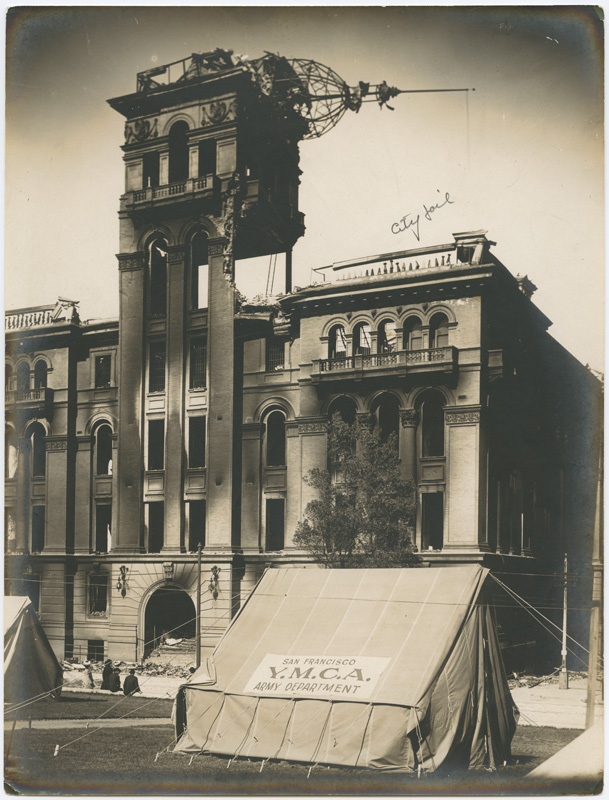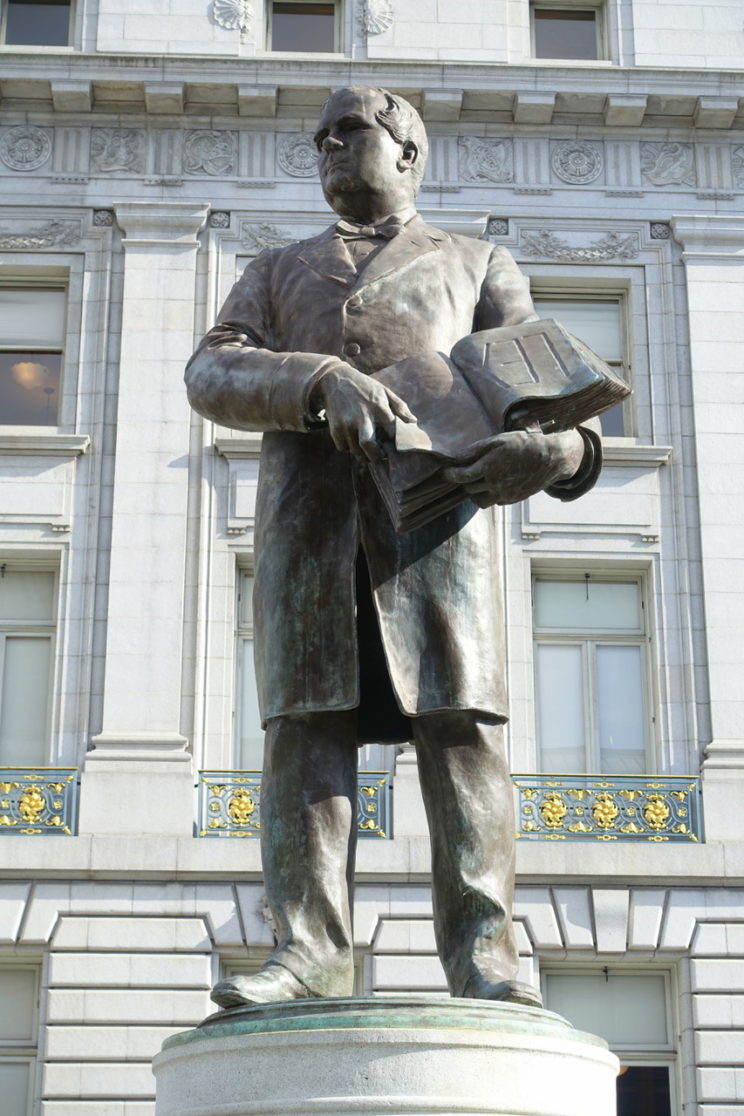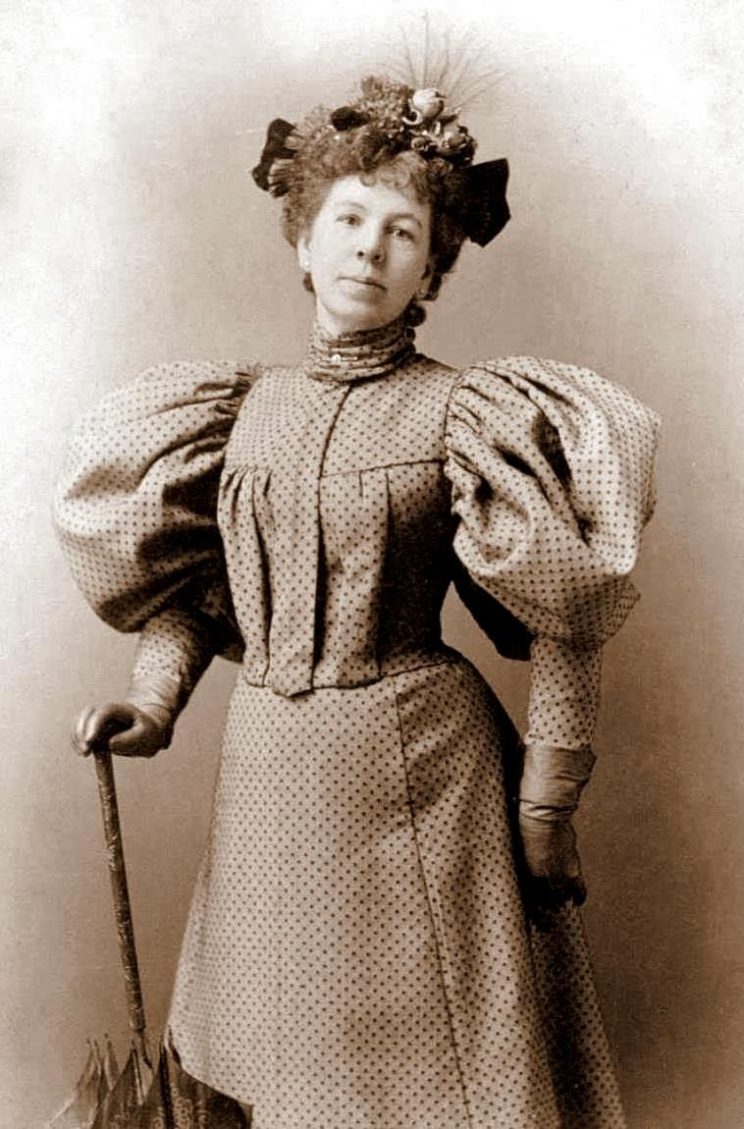“It was the social side which mainly characterized the association for a good many years, as far as available information goes.” J.O. Denny, The Bar Association of San Francisco: An Illustrated History (1923) p. 20.
The early records of the Bar Association of San Francisco (BASF), like most paper in San Francisco, were destroyed in the great earthquake and fire of April 1906. BASF today holds 37 boxes of archives, though none from its first 34 years of 1872 to 1906. As a result, early histories of BASF, based on the few surviving and accessible newspaper articles, suggested that it was an eating and drinking club rather than a professional society devoted to improving the administration of justice through law.

“The splendid and exceptional record of the organization in behalf of judicial reform, professional standards, court procedure, service to members,” wrote J.O. Denny in his fifty-year history of BASF, are forgotten “because no records survive.”
Here we explore the history of BASF before 1906, and especially its founding decade, using records recovered in the internet age. Early San Francisco newspapers are now scanned to the California Digital Newspaper Collection (cdnc.ucr.edu), scans of early BASF publications are online (hathitrust.org), and the Online Archive of California (oac.cdlib.org) points to relevant pre-1906 documents in established archives. These shards of data cannot replace a well-fed associational archive though they do illuminate some of BASF’s pioneering efforts to professionalize law in California. And, in a theme that recurs throughout the 150 years of BASF history, they show how BASF founders worked constantly to redefine then refine the proper and most effective role of a local voluntary bar association.
BASF did indeed start in 1872 as a social club, to fund a clubhouse to, according to its first mission statement, “cultivate social intercourse among its members.” Fourteen years before, according to a newspaper article on 20 February 1858, lawyers in San Francisco had first met to consider what they titled a “bar association,” to discuss rules on how they should interact, cultivate “fraternal feeling,” and fund a law library. No formal association came from that meeting though.
Over the next decade, as many as 180 attorneys, perhaps half of all those practicing in San Francisco, met occasionally and informally on weekends in empty courtrooms. They formed ad hoc committees to pass resolutions that defined their collective culture and ideals. These resolutions memorialized deceased luminaries, thanked admirable judges upon their retirements, endorsed candidates as judges, urged San Francisco supervisors to pay judges better, urged the state Supreme Court to disbar convicted attorneys. They also pooled donations to buy law books from which they might draw precedent to hew early laws fit to the energy of early California.
Such informal, local bars had appeared elsewhere around America in the mid-1800s, and prior to the proliferation of law schools in the 1880s. Who could practice law and how, like the law itself, was shaped by precedence and shared beliefs–beliefs inculcated through directed readings from elders and apprenticeships and professed jointly in voluntary assembly on Saturdays. In the early 1870s, though, two changes prompted San Francisco attorneys to formalize their bar as an association.
First, starting in 1870 California newspapers lit up with news of the newly incorporated Bar Association of New York, essentially a trade union of lawyers formed to bring transparency and mass opprobrium against the corruption of Tammany Hall, to insist all litigants get a fair hearing before the New York bench, and return the power of legal argument to judicial outcomes. The effectiveness of the Bar Association of New York inspired a wave of local, incorporated bar associations around America. BASF was the third to incorporate. BASF explicitly modeled its constitution and bylaws on those of the New York bar association, though with fewer committees given its more modest initial objectives. Even where judicial corruption was minimal, as then in San Francisco, and even where informal meetings of attorneys continued, incorporated bar associations proclaimed the goal of self-regulation. The American Bar Association formed in 1878, meeting in Seneca Falls, New York, was an attempt to define on a national level some commonalities among these local bars and advance a more consistent agenda for the professionalization of law.

The second big event, and perhaps the driver in formalizing BASF, was that the elite Pacific Club vacated its floor in the famed Montgomery Block. The four-story Montgomery Block (now site of the Transamerica Pyramid) was the tallest building west of the Mississippi when it opened in 1854. The Montgomery Block had become home to artists, bankers, and general swells, it was convenient to the courts, and it housed San Francisco’s voluntary law library then, and as it remained for decades, among the largest in America. Hall McAllister and Thomas I. Bergin, lawyers in demand by California’s newly-moneyed titans, convened a Committee on Permanent Organization, chaired by Colonel Joseph P. Hoge. BASF first met on 27 April 1872 and filed to incorporate with the city on 14 May as a benevolent society. BASF leased the entire second floor in the Montgomery Block and on July Fourth, at 93 members strong, hosted an open house of their clubhouse, glowingly reported in the Daily Alta California under the title “Gamaliel at Rest.” For decades afterwards, BASF selected headquarters buildings that provided welcoming meeting spaces for attorneys to socialize and learn.
Membership in BASF was nominally open to all attorneys, though actually selective. BASF membership required recommendation by a Committee on Admission of Members and a ballot of all members, then a steep $50 initiation fee and $5 monthly dues. BASF served the elite in the increasing stratification of legal practice. Most of BASF’s founding trustees and officers arrived in California in the 1850s, and served as appellate experts or outside counsel for the industrial firms dominating the West—railroads, mining, agriculture, shipping. Judges of any sort were honorary members. For its first three decades, until a democratization effort in 1901, only about a quarter of attorneys in San Francisco actually paid dues to BASF.
The club house had two billiard tables, served a hot lunch daily, and a sideboard always had snacks and liquor. Through the 1880s BASF also hosted clambakes on Angel Island. In March 1873 BASF sponsored a moot court, reported around the country, which argued the biblical homicide case of Cain and Abel using modern criminal jurisprudence. (No verdict was announced.) If newspapers characterized BASF members it was as lawyers who lunched, and drank; “to guzzle and gorge in quotidian fraternity” wrote the Examiner. But the BASF clubhouse did not only serve exclusivity. Lawyers with offices around the Bay Area could join and use it as their city office for client meetings and during trial. Three small apartments on the third floor were available to lawyers traveling in from other parts of the state. And any lawyer could subscribe to the library. Indeed, BASF hospitality served their goal of keeping San Francisco the capital of law in the American west.
BASF held business meetings annually, with the first in April 1873. They passed three resolutions that foreshadowed their larger goals. One resolution addressed legal ethics, in urging the state Supreme Court to disbar an attorney convicted of embracery, or jury tampering. One resolution addressed efficiency in the courts, in urging all courts in San Francisco to vacation in May and June. Law firms then were small, lawyers argued in all the courts, and unless the courts coordinated their vacations lawyers might argue in trials year-round with no time to prepare. The third resolution addressed the structure of California law, by creating a committee to urge reform of the revenue and corporations laws. The California Code was born the same year as BASF, 1872, as an ambitious effort to codify all the laws in California statutes. BASF members had strongly supported the codification effort, hoping it might serve as a vehicle to fix the economic portions of the existing California constitution and laws. (Indeed, over the next five decades, BASF committees actively helped in revising the Codes, hoping that that nut-and-bolts legal work was a vehicle to address largely legislative issues.) When the 1873 BASF committee on code revision issued its report a year later they called for a full-scale constitutional convention.
In BASF’s early decades, as reported in the newspapers, it is difficult to separate the activism of individual members from the activism of BASF as an organization. Joseph Hoge, president of BASF for its first eight years also served as president of the 1878 California constitutional convention in his personal capacity, and BASF founder S.M Wilson chaired its committee on judiciary and the judicial department. Only five other BASF members were elected delegates, while most delegates were elected from the Workingman’s Party and agrarian interests. BASF adopted only a few resolutions on the work of the convention, urging a new structure to the courts. The new constitution abolished all previous state courts, gave each county a new superior court, and established a new Supreme Court (with BASF member Robert F. Morrison serving as first Chief Justice). Otherwise BASF played a scant role in the organic structure of the new constitution, and most members expressed disappointment in it. BASF founder John Dwinelle derided it as “not so much a Constitution as a Code.”

Likewise, the Hasting College of Law started as a BASF effort to standardize and elevate education in the path to the bar, though BASF quickly lost control. In June 1878, BASF member S. Clinton Hastings founded the college with a $100,000 gift. All eight trustees were BASF founders, with the state Chief Justice serving ex officio. Students had access to the library. Within a year Clara Shortridge Foltz sued the college alleging that, as an affiliate of the University of California, Hastings trustees did not have absolute discretion over admissions and that the policies of the UC regents should prevail. She won, and Hastings slowly began enrolling women. Furthermore, the BASF trustees of the College saw it as vocational training while Hastings himself wanted to College to offer a liberal education, including legal ethics, intended to elevate the status of attorneys in California society. The rift between Hastings and his trustees deepened, so that from 1882 to 1885 the College functioned with no governing board, at which point the Regents of the UC system largely controlled College policy.
BASF had greater success in locating the state Supreme Court in San Francisco. After two decades of moving around the state, the code of 1872 fixed the location of the Court in Sacramento. In January 1874, after a year of commuting to Sacramento, BASF mailed a letter to prominent attorneys around California urging them to lobby the legislature to move the court to San Francisco. Local newspapers summarized BASF’s plea: four-fifths of the Court’s caseload originated in San Francisco, the main federal courts were there, as was the library, and the expense of travel to Sacramento disadvantaged poorer litigants. Good-natured ribbing about the delights and hospitality of each city ensued. BASF succeeded and in the spring of 1874 the Court heard arguments a block from the BASF clubhouse. The Constitutional Convention of 1878 left the location at the discretion of the legislature, so it remained a “court on wheels,” with an office in San Francisco though hearing arguments in Sacramento, San Francisco, and Los Angeles.
The important BASF work throughout the decades prior to the great earthquake, as increasingly reported in the surviving newspapers, included regular committees to study revisions to the pioneering California Code and to pass resolutions urging improvements to court procedure. Much of BASF’s agenda continued the work of the earlier informal bar. BASF coordinated court calenders, built a leading library, urged disbarment of disgraced attorneys, endorsed judge-candidates when an election mattered, and authored memorials of exemplary attorneys. In March 1879, though, some attorneys started a competing “United Bar Association of San Francisco.” The press never recorded the United Bar’s grievance against BASF, and it disbanded about September of 1883 following some meetings that failed to attract a quorum The press increasingly spoke of BASF as representing all attorneys in San Francisco, though it remained selective and elitist.
A 1901 effort by president Warren Olney to double membership launched the next era of BASF history. More members meant more committees, thus more opportunity for BASF members to try new initiatives so that the bar association ever better served the people of San Francisco–a tradition of redefinition begun almost with the founding of BASF.
Where BASF succeeded in its early years, and perhaps the most enduring legacy of its early years, was in asserting the importance of place in the practice of law. The clubhouse, a local college, the struggle over court location–each suggest that to function efficiently the bench must recognize that lawyers are people with homes, as well as clients,and that to function efficiently the bar must be structured to focus on the service of justice in its community.
About the Author:
Glenn Bugos is a historian of technology and business, based in Redwood City. He is currently helping BASF prepare its archive for its 150th anniversary celebrations.
